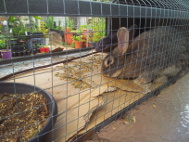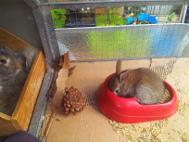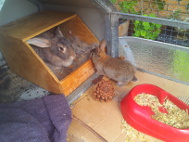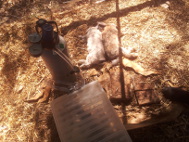This has been a long process so far, and we’ve learned a lot – mostly by doing it wrong and having to deal with the mistakes. The rabbits, for example, haven’t been nearly as successful as I’d hoped.
 We brought Tsuki the British Giant home almost 2 years ago. She was a bright, inquisitive bunny, about 4 months old, a soft tawny colour with good bone structure, good teeth (no hereditary issues visible) and she was already a big rabbit. The idea was that we’d get a boy bunny, and Tsuki would be the mother of a line of meat rabbits. We’d keep a few of her babies to breed with, but most of them would end up as dinner. Tsuki herself, our matriarch to be, was not going to be eaten – she was going to have a long, happy life full of hay and tasty grass and greens and lots of baby bunnies.
We brought Tsuki the British Giant home almost 2 years ago. She was a bright, inquisitive bunny, about 4 months old, a soft tawny colour with good bone structure, good teeth (no hereditary issues visible) and she was already a big rabbit. The idea was that we’d get a boy bunny, and Tsuki would be the mother of a line of meat rabbits. We’d keep a few of her babies to breed with, but most of them would end up as dinner. Tsuki herself, our matriarch to be, was not going to be eaten – she was going to have a long, happy life full of hay and tasty grass and greens and lots of baby bunnies.
Our first boy bunny, Tlaloc, died mysteriously. Rabbits do that sometimes. He was a chinchilla grey Flemish Giant cross, and a sweet bunny. But these things happen, and we moved on.
The second boy bunny, Mouse, was a Californian / Dwarf Lop cross. Not the ideal sire for a meat rabbit line, but he was what we could get at the time. We named him Mouse because as a baby he was quite timid, and would hide behind things like a little mouse.
Mouse took some time to get the hang of breeding. He was smaller than Tsuki, so he had trouble convincing her that he was a full grown male, and at first she wouldn’t let him near her. Eventually she relented, but Mouse then had to work out which end to go for. He did a lot of humping her head before he figured out what the raised tail at the other end meant. He did get it eventually – and Tsuki then had a false pregnancy for a month.
The second time around she gave birth, but we found dead baby bunnies the next day. At the time we thought that perhaps she’d gotten a fright and tried to eat the babies – as rabbits will sometimes do. Turns out – as we discovered on the next litter – that it was actually rats. They came in at night and ate the (still living) babies while Tsuki watched fearfully from a perch nearby. The third litter died from some mysterious rabbity illness of the bowels, except for one baby boy. Tsuki was a good mother, and raised the one baby very successfully.
 Because there was only one, we didn’t eat him. Instead we named him Brighteyes, and thought we’d keep him – since the idea was always to get at least one more doe to broaden our genetic pool. Mouse still wasn’t the best choice as a sire, so we thought that perhaps we could keep Brighteyes as the boy bunny, and mitigate the inbreeding by including a couple’ve totally unrelated females in the herd.
Because there was only one, we didn’t eat him. Instead we named him Brighteyes, and thought we’d keep him – since the idea was always to get at least one more doe to broaden our genetic pool. Mouse still wasn’t the best choice as a sire, so we thought that perhaps we could keep Brighteyes as the boy bunny, and mitigate the inbreeding by including a couple’ve totally unrelated females in the herd.
 We moved the rabbits all up to Gallifrey, to a larger colony pen there, and went up twice a week to fill up their food and water dispensers. A lot of work, but it was only going to be a couple’ve months until our house was built and we could move up there ourselves. (The house is still in progress – we now have building permission, so with luck we’ll be in.. soon.) It worked quite well, in spite of the extra work of heading up there twice a week to check on the rabbits. A fourth litter was born successfully and the ten babies grew well.
We moved the rabbits all up to Gallifrey, to a larger colony pen there, and went up twice a week to fill up their food and water dispensers. A lot of work, but it was only going to be a couple’ve months until our house was built and we could move up there ourselves. (The house is still in progress – we now have building permission, so with luck we’ll be in.. soon.) It worked quite well, in spite of the extra work of heading up there twice a week to check on the rabbits. A fourth litter was born successfully and the ten babies grew well.
Then – next lesson – we put in a new, updated food trough for the rabbits. Unfortunately, it was low enough for the babies to jump into it, and high enough to be above the baby-proof wire around the bottom of the pen. All ten babies jumped out of the pen and were lost. We saw a few of them hanging around for the next week, but although we tried making a ramp (baited with grain and chaff) for them to get back into the pen and their mother, they weren’t smart enough to use it. We still had only a single surviving baby rabbit (Brighteyes) from this whole period.
So we fixed the fencing, and we fixed the feed trough, and we fixed the nest box. We separated the bunnies, and then put Mouse in with Tsuki again to try for another litter. And then we waited to see if she was pregnant. Before we could find out, she got sick. She seemed a little unwell, sniffles and a bit lethargic, so we separated her form the other two and quarantined her to see how she went. She seemed to have some facial swelling, and we wondered if she’d been stung by the bees (which use the rabbits water containers to drink from as well) and was just having an allergic reaction. This was not the case.
In 1950, the Australian government released myxomatosis, a rabbit pox disease, in an attempt to control the feral rabbit population. At the time, it had a 90% death rate; it now has about a 50% death rate in the wild (feral) rabbits – but in pet rabbits the death rate is still around 90%. A vaccine exists, but is illegal in Australia because it is a live virus vaccine, and might conceivably get out and enhance the resistance in the wild rabbit population. Tsuki had myxomatosis. Mouse and Brighteyes started showing symptoms a week after Tsuki.
Myomatosis is a horrible disease. It causes tumours in the facial and genital regions, and swells the airways shut, starving the animal of oxygen. It depresses the immune system, leading to secondary infections. And there is no cure. Vets advise euthanasia in every case. So, the weekend before easter, we killed our rabbits. One at a time, we picked them up and placed them int he controlled atmosphere killing chamber we’ve made, and piped in nitrogen gas until they fell asleep due to oxygen deprivation. Nitrogen doesn’t cause the feeling of suffocation that carbon dioxide does (although rabbits and other rodents actually don’t suffer from that anyway, so carbon dioxide is a safe and humane gas to use on them – on other mammals and birds it produces the feeling of suffocation due to carbon dioxide buildup in the blood). The bunnies went gently to sleep, and did not wake up.

I don’t know if we’ll try again with rabbits. On paper they still work really well – but myxomatosis is mosquito born, so we’d have to make a mosquito proof pen for them if we did keep them, and that’s not easy. We might try guinea pigs instead; they breed more slowly and they don’t taste as good, but they’re not susceptible to myxoimatosis (or any other massively fatal disease which is illegal to vaccinate against).